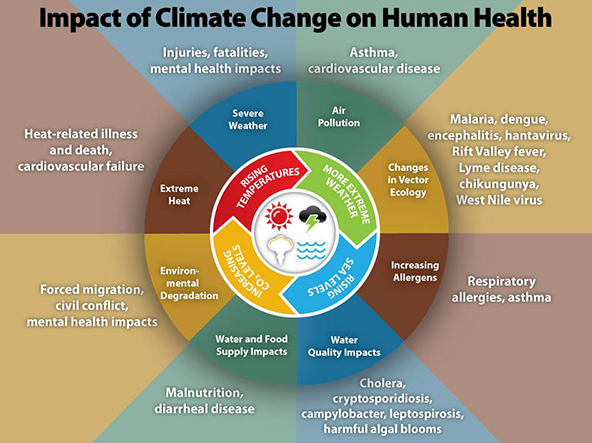Climate Change and Health
What You Need to Know
- Climate change is happening and expected to continue.
- A changing climate affects health and increases risks for illness, injury, and death.
- Certain people and places are at greater risk of climate-related health impacts.
- Responding to climate change protects human health.
Climate change is happening when there are significant changes in weather patterns— such as temperature, precipitation and wind patterns — that occur over years, decades, and centuries. While climate change is a global problem it can affect people and places differently.
Not all New York State communities experience climate change in the same way. In some areas, temperatures may increase while they decrease in others. Increases in temperatures also affect air pollution levels in New York State communities. Extreme weather, such as heat waves, droughts, torrential rain, and hurricanes, also may happen more frequently in some communities than others. Learn more about climate change in New York State.
What is Causing Climate Change?
Human activities, such as burning coal, oil, or gas for energy, clearing forests, and farming practices increase levels of carbon dioxide and other greenhouse gases. Greenhouse gases trap heat in the atmosphere and cause rising temperatures, warming oceans, and rising sea levels. Learn more about what causes climate change.
How Climate Affects Health

The scientific understanding of climate change is evolving. We know that changes in climate affect health in many ways. For example, droughts and severe floods can affect drinking water quality, food safety, and air quality which can increase risks of illness and injury. Extreme heat and extreme cold increase the risk of serious health problems, including heat stroke or hypothermia, and can worsen chronic conditions such as asthma, heart disease, and diabetes.
Climate change also increases the risk of infectious diseases transmitted by ticks and mosquitos, such as Lyme disease or West Nile Virus. These diseases can spread where changes in temperature and rainfall provide better breeding conditions for ticks and mosquitos.
Responding to Climate Change
New York State works to address climate change and protect New Yorkers:
- The Climate Leadership and Community Protection Act (Climate Act), which was passed in July of 2019, is among the most ambitious climate laws in the nation. The Climate Act aims to reduce greenhouse gases from 1990 levels by 40% by 2030 and at least 85% by 2050 by increasing renewable energy use and ensuring all communities equitably benefit in the clean energy transition.
- New York State’s Extreme Heat Action Plan identifies and supports initiatives to keep residents safe and prepare communities for rising temperatures.
- New York State's emergency preparedness programs protect New Yorkers, their property, and our economic well-being from emergencies and disasters.
What You Can Do
Follow these steps to help protect yourself and your family:
- Be informed and prepared: Learn more about emergency preparedness, extreme storms and flooding, outdoor air quality, harmful blue-green algae blooms, extreme heat and extreme cold weather, and tick-borne and mosquito-borne diseases.
- Find out about how climate change affects your community: Use our Air Quality Index, Heat Vulnerability Index Maps, and Environmental Public Health Tracker.
- Use tools and resources that can help you cope with changes in temperature such as the NYS Cooling Center Finder and Cooling Assistance Benefit Program.
Reduce your carbon footprint and impacts on climate change.
Energy
Save energy by looking for ENERGY STAR products and learn how to save energy at home.
Waste
Reduce waste and reuse products by recycling and composting. Find a recycling or composting station near you.
Transportation
Reduce your fuel emissions by greening your commute and biking, walking, carpooling, or taking public transportation.
Water
Conserve water at home by installing low-flow shower heads, finding water leaks, and landscaping with plants that need less water.
Environmental Justice
Learn what climate issues threaten your neighborhoods, who is most vulnerable, and how you can help.
Do More
Learn more about climate change science and participate in in citizen science projects.